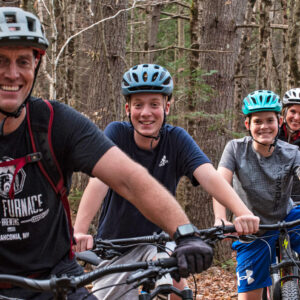Caught in the Middle: Why We Need Housing Solutions for Young Professionals
This column was featured in VT Digger, Adirondack Daily Enterprise, and the Concord Monitor [NH].
Twenty years ago, my wife and I were young professionals determined to purchase our first home before the birth of our daughter. We barely made it.
It was 2001, in a periodic seller’s market where properties were listed for hours, not days, and cash offers above listing price were routine. What we thought was a challenging market then now seems easy compared to the past two years. Limitations of skilled labor and developable land, unpredictable supply chains, and gravitation to high profit margins in higher-end homes have led to a dearth of development in the price range that works for young people making their way in the world.
Crisis Compounded by Covid
This crisis of middle-income housing rages throughout the Northern Forest states of Maine, New Hampshire, Vermont, and New York and has been compounded by a Covid-induced retreat to attractive rural communities by urbanites. (Sales of homes over $1 million tripled in Vermont in 2020 after languishing on the market pre-pandemic.[i]) This has made it even more difficult for people to find permanent homes in places that already have high second-home ownership rates. Using several towns where the Center works as a sample, we see high portions of their homes categorized as seasonal or occasional use: Greenwood, Maine – 51%; Greenville, Maine – 60%; East Burke, Vermont – 40%[ii]; Long Lake, NY – 96%[iii]; Blue Mountain Lake, NY – 96%[iv]; Colebrook, NH – 60%; Lincoln, NH – 70%.[v] [vi]
While Covid produced increases in the region’s population and helped – at least in the short term – address an overall loss of people from the region, unintended negative consequences abound, including significantly higher home prices and conversion of many long-term rental properties to second homes or short-term rentals. The impact on community: young people are increasingly left out of the housing market and quality rental units are nearly impossible to find.
Clearly, there are serious challenges at the low-income end of the housing market as well, but many federal and state programs support non-profit housing development restricted to low-income residents. These programs do not fully meet demand, but resources and political will exist, and are increasing, to help the most vulnerable populations, and sophisticated non-profit housing developers are using them in communities across the region.
Housing Squeeze for Middle-Income Earners
The rise of high-end homeownership at one end of the housing spectrum and efforts to increase the volume of income-restricted housing at the other end leave middle-income residents with very few options. This has disastrous implications for our communities and economy. Ask any rural employer seeking to fill open positions and they will cite the lack of quality, attainably-priced housing as a primary obstacle to attracting or keeping talent. In some cases, employees are driving hours round trip for work, increasing their transportation costs and the associated environmental impact. In other cases, crucial jobs in hospitals, schools, and manufacturing are going unfilled – further contributing to community decline.
Our region desperately needs solutions for middle-income housing.
Integrated Capital Approach and State Experiments
At the Northern Forest Center, we are addressing this problem in specific communities, building on our successful redevelopment work in Millinocket, Maine, and Lancaster, NH. We’re now a developer ourselves, creating a new model using integrated capital to improve existing downtown building stock and return it to productive use. Our model allows for a longer timeframe and deeper investment than traditional developers can accommodate. In many cases, catalyzing additional private investment requires taking on a community’s worst and most expensive renovations. This is slow work. It needs to be accelerated and replicated in many more communities to meet the scale of demand for middle-income housing.
Improved policies and funding targeted to in-town redevelopment would not only make it more attractive for developers to serve the crucial middle-income market, they would also accelerate community and economic development goals. We’re particularly interested in what’s developing in New Hampshire, where a proposed $100-million InvestNH Housing Incentive Fund would be managed through the Department of Business and Economic Affairs. This is a bold experiment to help address the critical housing gap that serves communities’ identified needs and doesn’t restrict occupancy by income.
The Vermont Senate is also contemplating a bill to direct more resources, potentially without income restrictions, with a focus on rehabilitating vacant downtown buildings for housing. This would bring vibrancy to downtowns and encourage young professionals to make their homes there.
Some have and will criticize these approaches. But we all have an interest in making our communities more accessible to middle-income individuals who want to live in rural places. They’ll not only fill jobs, they will also contribute to social vitality, shop at local businesses, and perhaps add kids to local schools. If we do this well by encouraging in-town development, increasing energy efficiency, and sourcing local materials, we’re demonstrating clear values that can attract people committed to a broad sense of community and environmental stewardship.
The Center is all in on being part of the solution and is eager to see new policies and approaches take root to support a New Forest Future in the Northern Forest.
Endnotes
[i] Sales of $1M homes tripled in Vermont last year – VTDigger
[ii] ZIP Code 05832 Map, Demographics, More for East Burke, VT (unitedstateszipcodes.org)
[iii] https://mylonglake.com/wp-content/uploads/2020/01/Inventory-and-Analysis_Final.pdf; page 4.
[iv] ZIP Code 12812 Map, Demographics, More for Blue Mountain Lake, NY (unitedstateszipcodes.org)
[v] Data Reveals Vacation Home Hot Spots Across the Country – IPX1031
[vi] New construction was characterized as high-end, second home, retiree, or vacation construction…. Additionally, many noted the conversion of second homes to permanent residences for relocating retirees. Nearly all multi-unit new construction observed around the region is publicly developed or financially supported workforce or affordable housing. The cost of construction was noted by most groups as a barrier to construction in general. (North-Country-Housing-Needs-Analysis-2021.pdf (nhhfa.org)



